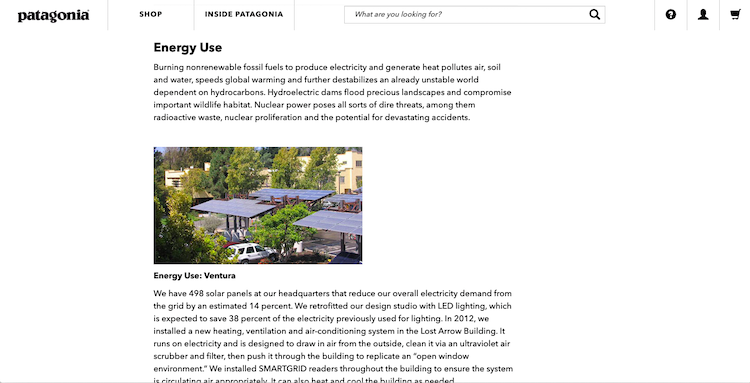How to Effectively Market Your Sustainability Efforts

How to Effectively Market Your Sustainability Efforts
Contributed ContentThe demand for environmentally-friendly products and services continues to grow, but competing on sustainability in today’s market requires more than buzzwords. Learn what your business needs to do to win on sustainability.
The trend of consumers giving increasing preference to socially- and environtmentally-responsibile businesses is nothing new — but it continues to grow.
Research conducted by Nielsen in late 2018 shows that 48% of U.S. consumers said they would “definitely or probably change their consumption habits to reduce their impact on the environment.”
Data shows that spending among consumers is consistent with the self-reported preferences: Nielsen forecasts that by 2021, sales of sustainable products will reach $150 billion — up from $107.3 billion in 2014 shown in the Sustainable Product Sales in the US chart.

Looking at the optimistic forecast, conservative forecast, and actual sales show this growth is a likely trend moving into 2020 and on.
The opportunity for businesses selling direct to consumers is self-evident, but if your business is trying to sell to other businesses using sustainability-focused messaging, there are as many challenges as opportunities.
Let’s assume that your business does indeed have legitimate environmentally friendly practices to tout: how can you navigate the common hurdles of selling sustainability to businesses and win with this message?
How to Market Your Sustainability Efforts
- Refine audience targeting
- Get specific about your sustainability
- Establish your long-term commitment to the environment
- Build corporate partnerships
1. Refine Audience Targeting
You should always be trying to target an audience your business will benefit from.
When marketing sustainability to other businesses, there are two key dimensions of targeting to plan for: the company and the buyer.
Identify the Right Company
Businesses that publicize their sustainability objectives are more likely to gravitate to suppliers that are aligned with their goals.
To find these companies, search for those in your target market that have environmental objectives with defined targets shared on their websites.
You can also uncover these companies by looking for those with third-party certification from bodies such as the Forest Stewardship Council (FSC) or the International Organization for Standardization (ISO).
By integrating this dimension of targeting into your plan, you’re significantly improving the chances that your message will find a receptive audience and positioning your business correctly.
Pitch to the Right Buyer
The next dimension to plan for is the buyer. As you consider your environmentally-minded prospects, there’s a good chance that the procurement and purchasing people are not the ones in the company who care most about sustainability.
Generally, they’re keener on checking boxes on things like inventory, price, and reliability that will make their day-to-day jobs easier.
Knowing this, if you’re selling sustainability to procurement and you can’t beat their existing vendor on service, price or quality, your campaign stands little chance of succeeding.
When this is the case, the better bet is to take a top-down approach and find a way to sell your sustainability benefits to the director, VP or C-level executives who are champions of this cause.
This way, you are speaking to the people who have the authority to influence management and procurement to buy from your business.
While this may be easier said than done, the extra work will pay off if there are high-value accounts that fit this mold.
2. Get Specific About Your Sustainability Efforts
In today’s market, your business won’t stand out by talking about sustainability commitment with buzzwords or vague terms.
The number of businesses competing on sustainable, green, or environmentally-friendly positioning has skyrocketed. This means insubstantial claims and meaningless buzzwords are not going to resonate with your potential customers.
To break away from this pack, lose the buzzwords and highlight tangible, specific benefits that truly matter to your buyers. For example:
- Do your shipping and/or sourcing practices result in less water consumed or fuel used? How much?
- Will your product help your customers limit their carbon emissions? By how much?
- Do you use recycled materials in your facility or products? How much waste are you eliminating as a result?
- Does your product avoid the use of toxic or hazardous materials that your competitors might use?
- What environmental impact is achieved by switching to your product?
Go the extra mile for your buyers and quantify the impact with some of these questions and answers. If you can provide a calculator that lets them use their own numbers to see for themselves, even better.
Patagonia, for example, provides specific documentation on its practices and their impact, rather than simply stating that Patagonia has invested in efficient and renewable energy sources.
In a section on their website highlighting energy use, they note that “We have 498 solar panels that reduce our overall electricity demand from the grid by an estimated 14-percent.”

You don’t need 498 solar panels to quantify the impact of your sustainable practices, but make note of all processes, materials, and practices that make your product environmentally friendly.
When you calculate the exact impact on energy, resources or footprint your company has, you can promote that number to potential customers.
Use video, images, and infographics to illustrate the benefits in a simple format. Then, promote these benefits on your website and through your content, social media and sales collateral.
3. Establish Your Long-Term Commitment to the Environment
Hardly any brands take ownership of environmentalism to the extent that Patagonia does, so it’s vital to consider what they’ve done to earn this distinction.
Patagonia has scaled its sustainability efforts in ways that small and medium businesses may not be able to achieve. Still, Patagonia offers a helpful case study for businesses looking to market their sustainability efforts.
Patagonia went organic in 1996 after commissioning a study that found conventional cotton to be one of the most destructive crops in the agricultural world.
From there, Patagonia began measuring the impact of its entire supply chain, kicking off an ongoing project called The Footprint Chronicles® to provide transparency to customers and stakeholders.
Following in Patagonia’s footsteps, if you have a long history of environmentally-minded practices, make this a prominent part of your message to differentiate you from those who have more recently jumped on this bandwagon.
No long history to draw from? You can still tell the story of how and why you first adopted sustainable practices to demonstrate your commitment and add texture to your mission.
4. Build Corporate Partnerships
If you haven’t already, research the authoritative environmental associations, certifying bodies and organizations in your industry.
Plan to join or become certified by industry authorities that align with your values and practices. Then, be sure to promote those alliances and recognition.
Social proof is a powerful tool, so if you’re able to point to certification or membership from a recognized name like B-Corp or the EPA, you’ll have a powerful advantage over competitors that cannot.
For example, nodding to the reality that addressing today’s ecological challenges requires cooperation, Patagonia also uses its website to highlight the various corporate partnerships they belong to — from The Fair Factories Clearinghouse to The Conservation Alliance – that focus on improving environmental and social business practices around the world.
Use Sustainability To Stay Ahead of The Curve
Unless things change drastically, demand for sustainable business practices will continue to increase, which means that not only will more businesses strive to meet this need, but that your competitors’ marketing around sustainability will evolve and become more sophisticated.
By sharpening your targeting now, avoiding vague buzzwords, and speaking to the specific benefits of your efforts, there’s a big opportunity to use digital marketing to win over your audience.
By looking ahead to what’s next and dedicating resources to ongoing innovation, you can position your business to stay ahead of the competition in the future and keep loyal customers.
